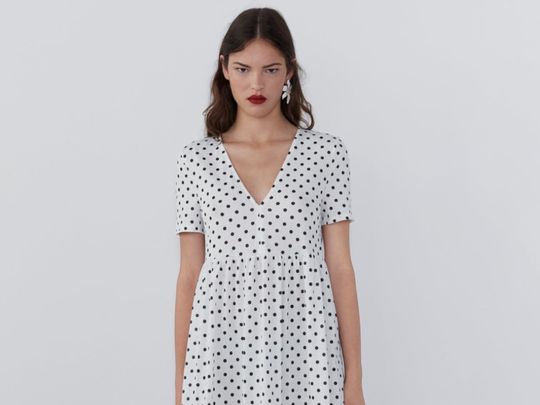
The most viral fashion item of the summer thus far is not Janties (denim panties, obviously), or the bucket hat, or the “big mood socks” being worn at festivals across the Western Hemisphere. Rather, it appears to be a simple black and white viscose printed polka dot dress by the fast fashion giant Zara, with a price tag of 39 pounds and 99 pence, or $50, or Dh183.63.
It’s become so ubiquitous in Britain, it is known simply as “The Dress.”
Indeed, “The Dress” has become so wildly popular over the past three months that it recently spawned its own Instagram tribute account, @hot4thespot. Set up by stylist Faye Oakenfull, the account offers its almost 5,000 followers the opportunity to submit photos of dress sightings on the subway, on sidewalk crossings, at supermarkets, and in church (among other places) across Britain. But entries have started to come in from all over the world.
“The Dress and I originally met on a set back in Easter when both the art director and make-up artist came in wearing it. I posted it on my Instagram story as an ‘awkward fashion moment,’” Oakenfull said this week, adding that she doesn’t own the dress herself.
“It then started to escalate, with many people sending me their own sightings. After a few weeks it seemed to be so popular on my stories that I decided to start a new account to keep on top of the content.”
While the oldest wearer to be featured was 80 (that one is also the most popular post to date, with 780 likes), Oakenfull said @hot4thespot had revealed there was a particular “type” of fashion consumer for whom the dress held particular appeal.
“I can be pretty certain where she’ll be hanging out at weekends,” Oakenfull said of the demographic. “She loves a bottomless brunch, food markets, day festivals, tennis, baby showers (sometimes hers), hen dos, polo, work parties, weddings, rooftop bars and poolside prosecco. Most of all, she just really loves food shopping in Marks & Spencer.”
Cultural trends rooted in mass consumption — and with a tinge, thus, of unoriginality and predictability — have become popular subjects on social media in recent years, picking up the slightly catty nickname “basic.”
@hot4thespot errs firmly on the side of lighthearted, as opposed to unkind, commentary.
However, the project has attracted critics, including stylist Sophie Benson, who called out @hot4thespot and other similar social media accounts created in the wake of viral fashion trends, for snapping and sharing images of women going about their daily lives without their consent.
“Women have enough to worry about when they’re in public; catcalling, up-skirting, being followed, being harassed, being grabbed or touched. They don’t need the added anxiety of wondering whether someone might be photographing them with the intent of sharing it with thousands of people,” Benson wrote in a column for Metro, a free British newspaper, earlier this week.
That said, the risk of being gently and publicly teased for being part of an enormous fan base that stretches across ages, races and sizes has done little to quell the popularity of the frock.
According to Laura Antonia Jordan, the fashion news and features director at Grazia magazine, it is the high numbers of real women — rather than celebrities, royals, or influencers — who love the spotty dress that have given this particular phenomenon added cultural credence.
“That dress is democratic fashion in action,” Jordan said. “Not everyone wants yet more florals or to strip off for the summer, and that light and floaty dress — with its loose sleeves, nipped waist and ankle length ruffled hem — will suit most women. The fact that it is versatile, affordable, and readily available given there is a Zara store near most people in Britain, has fuelled the fad.”
So has the clear movement, in the wake of #MeToo, away from body-con and baring skin toward modesty. After a period of dominance for dystopian, aggressive streetwear in womenswear, led by designers such as Demna Gvasalia, a shift toward romance — couched in comfort and practicality — has started to emerge, and is encapsulated in pieces like the spotted Zara dress.
The virality of this latest garment and others that have come before it, as well as the online discourse built around it, is also a clear example of the power of social networks, and the fact that in an increasingly digital age, many customers want to see their favourite brands or purchases on display on people just like them, affirming their buying decisions and reassuring them they are part of the crowd.
“Viral fashion is sometimes less to do with the style or aesthetic and more to do with the catalyst or instigator,” said Sarah Owen, a senior editor at the trend forecasting company WGSN.
Zara declined to comment on the success of the spotty $50 dress this week. However, the previously sold-out item appears to be available online across multiple geographical markets, in every size from extra small to extra large. Which suggests either that the retailer, known for a flexible production model that allows it to capitalise on growing style trends or unexpectedly popular items faster than its competitors, is expecting a further wave of spotty-dress buyers — or that the fad may have reached its apogee. In which case, get ready for the next.
















